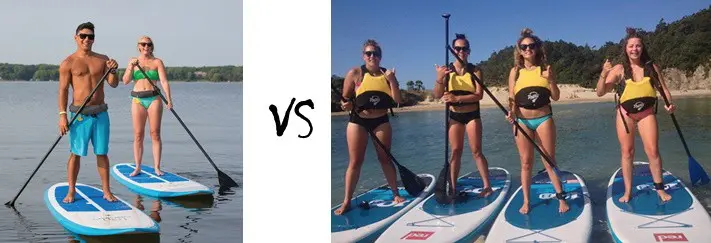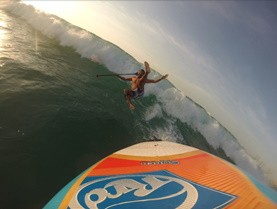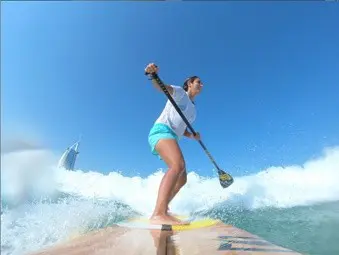Paddle boarding Safety: A Quick Guide For Beginners
So, you’ve been bitten by the popularity of stand up paddle boarding. It’s not surprising that you’re hooked into this exciting water sport. From the vast waters of the oceans, down to the rivers and lakes, most people are getting crazy about paddle boarding.
Hey, who doesn’t want to enjoy the thrill of being one with nature while having a nice body workout at the same time, right?
But don’t be too complacent. Every great adventure has its own risk. Although paddle boarding is generally considered a very safe activity, you should still observe safety measures to ensure that you’re safe while having some fun.
You have to understand that proper SUP training will help you learn the basic paddle boarding safety procedures. Keep in mind that your safety should be your utmost priority. Here are the things that you need to know to stay safe on the water:
Don’t forget to use your SUP safety equipment.
Buoyancy Aids or PFD (Personal Flotation Device)
This is the most important thing that you should have in mind before you even go to the water. It doesn’t matter whether you are a beginner or a seasoned paddler. Accidents happen in a snap so you better be prepared at all times. The Buoyancy aid device known even as life jacket will save your butt when the worst thing happens.
There are different types of PFDs depending on which type of paddling you’re going to do. If you’re going for a surfing adventure, the best option is a belt pack PFD. It’s lightweight and comfortable to use while surfing. Now, if you just want to relax and enjoy the flat lake waters, a traditional life jacket would be enough to keep you safe.
SUP Leash
This is another very important paddle board accessory that you don’t want to overlook. It will keep you from getting separated from your board. You see, paddle boards price range from $1200 to $1500 and it’s very painful to see it drifting away… never to return again.
Oh, one more thing. Aside from losing your precious board, getting separated from it can be very fatal if you don’t have a life jacket. So don’t be too foolhardy enough to paddle board without a leash. Remember, safety is your utmost priority before anything else. With that said, you can eliminate the risk by wearing an ankle leash. It’s very easy to get a paddle board safety leash either from our paddle board shop in Dubai located at Nessnass beach or through our water sports online shop.
Understanding the terrain.
There are many different SUP boarding terrains that you need to consider. Some people want the thrill of surfing by the oceans. Others enjoy the calmness of flat waters in lakes while others want to go wild on a whitewater paddling adventure. Whatever you do, make sure you have a keen understanding of the terrain.
Let me explain. Let’s say for example you’re out there surfing at the beach, there are a lot of factors that can cause accidents while you are riding the waves. The danger of colliding with other surfers can be fatal if you don’t know what to do or getting whip out by a wave can really be dangerous if you don’t know how to fall properly and away from you paddle board. With that said, proper training and awareness should be observed before you start Sup surfing.
Monitor the weather condition and surrounding area.
The changing weather condition and the unpredictable environment can pose danger to a clueless paddle boarder. Before you go out and start paddling in the waters, you have to check the weather first. See if there’s a pending storm or any weather disturbance. Some of the factors that can be a problem while paddle boarding are the following:
Tide – The rise and fall of sea levels greatly affect your travel time when you’re in an open sea paddling or in the mangroves. Being aware of the tides will help you plan your route ahead of time. This is to avoid exhaustion and for you to be able to go back safely to the shore.
Wind – This is one of the most important parts of your surroundings that you need to be aware of before paddling out in the waters. Check the wind forecast to determine if it is safe. Ideally, it’s quite safe to paddle out if the wind is moving below 10 knots. But then, if it blows above 10 knots, I suggest you wait until the wind slows down.
The most dangerous wind direction is the offshore wind. What makes it risky is that it will push you away from the shoreline if you don’t know what to do.
The further you are away from the shoreline, the stronger the wind blows. You’ll drift away faster as the wind gets stronger. This will make it harder for you to go back to the shore as you are paddling against the wind.
If you used to paddle back to the shore within just 5 minutes, with offshore wind, it will take you an hour to do that. And that can be risky if you are still an inexperienced paddler. That’s why it is very important to know how to deal with different wind conditions.
Time – You have to be aware of time if you want to paddle board for a longer period. Why is this important? You see, getting out in the open waters can be so much fun. The thing is, you must be having a good time without realizing it’s already getting dark. It’s not really advisable to paddle board at night due to poor visibility. Think about it, nobody wants to get lost in the open seas!
Waves and Swell formation – Knowledge of water movements in the ocean is very important. This is critical in keeping you safe while still having fun in the water.
Swell is often referred to as surface gravity waves. This is different from the waves generated by the local winds. It is actually generated by distant weather systems wherein the wind blows for a long period of time over a fetch. Some people call it the hills, others refer to it as the valleys of the seas.
A swell wave typically has a long wavelength and it usually travels very fast and at long distances. Sometimes it creates bigger waves. These bigger waves can make it difficult for you to paddle surf if you are an inexperienced paddler.
So as to avoid confusion, the waves produced by the local winds are often called the choppy waves. These waves travel slow and can occur on almost any type of water. It can whip up real quick but vanishes just as fast.
If you noticed that the waves are bigger than what you are used to experiencing from the local beach, then you better think twice before you jump into the water and paddle surf.
Make sure you cover up
Paddle boarding can be really exciting and it’s also a great way to enjoy the outdoors. However, getting too much exposure from the sun could result to severe and painful sunburn. It may also lead to skin cancer if you keep on getting exposed to the harmful UV rays.
If you plan to spend a significant amount of time on the water, then you must use protective gears to cover your body from the UV rays. Wear a hat that can shade your whole face and upper body. You can also put on a wetsuit that covers your arms and legs. It’s also better if you use a waterproof sunscreen lotion.
CONCLUSION
Stand up paddle boarding has significantly gained popularity in recent years. Our goal is to educate each and every one about the importance of following proper safety procedures. The items that are mentioned in this article are very essential part of paddle boarding safety. We hope that you gained some valuable knowledge today and we encourage you to apply these tips every time you go for a paddle board rental. In case you need an advise about the different paddle board accessories or you looking to buy a paddle board in Dubai and you are confused between the different paddle boards models and sizes you can visit our paddle board shop in Dubai or can navigate online shop paddle boards.





Thank you for this, it is very informative for a new boarder. I wonder if there are any websites or apps that you would recommend for the tides, wind and weather for Abu Dhabi?